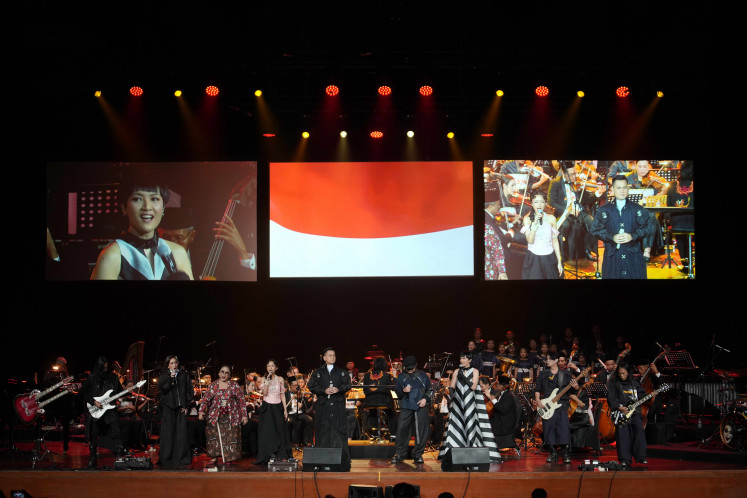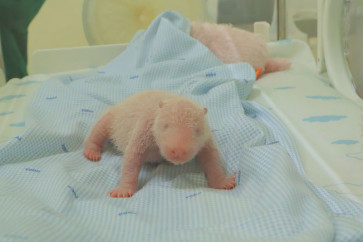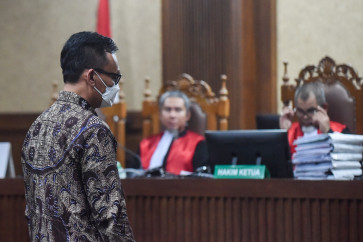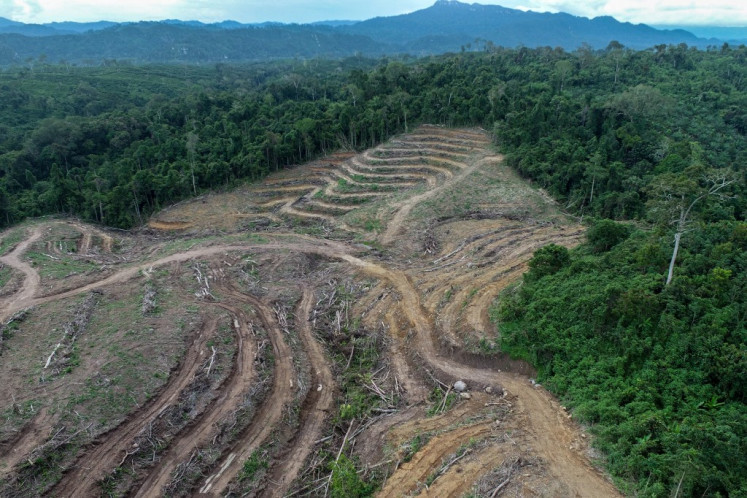Popular Reads
Top Results
Can't find what you're looking for?
View all search resultsPopular Reads
Top Results
Can't find what you're looking for?
View all search resultsAboriginal Art: Connecting the dots
Finished: Aboriginal artist Ronald Nawurapu Wunungmurra shows the finished painting of a seabird catching fish at the Arts and Ceramics Museum in West Jakarta
Change text size
Gift Premium Articles
to Anyone
![Finished: Aboriginal artist Ronald Nawurapu Wunungmurra shows the finished painting of a seabird catching fish at the Arts and Ceramics Museum in West Jakarta." border="0" height="375" width="511"><span class="caption"><strong>Finished: </strong>Aboriginal artist Ronald Nawurapu Wunungmurra shows the finished painting of a seabird catching fish at the Arts and Ceramics Museum in West Jakarta.</span></span></p><p>Coming all the way from Yirrkala, a small town on the northeast tip of Arnhem Land, about 700 kilometers east of Darwin, Australia, Ronald Nawurapu Wunungmurraâs visit to Indonesia was a noble gesture.</p><p>Every July, Australia celebrates the National Aboriginies and Islanders Day Observance Committee (NAIDOC) Week. Nawurapuâs stopover in Indonesia was part of the celebration. This yearâs theme was âWe All Stand on Sacred Ground: Learn, Respect and Celebrateâ. It highlights the strong spiritual and cultural connection the Aboriginal and Torres Straits Islander people have to the land and the sea. <br><br>âIâm very excited to come on this trip, itâs really interesting for me to meet people,â Nawurapu told <em>The Jakarta Post</em> as translated by Will Stubbs, art coordinator for the Yirrkala Arts Center. <br><br>âI feel itâs important because it seems that people on both sides have forgotten a long relationship that binds us together, the Yolngu people [of the Yirrkala] and Makassan,â added the Aboriginal artist after leading an art workshop at the Arts and Ceramics Museum in Kota Tua, Jakarta, in early July.<br><br>By Makassan, Nawurapu means Makassar in South Sulawesi, whose people are known as excellent seafarers.<br><br>A couple of days later, Nawurapu attended a presentation of Yirrkala Aboriginal Pekalongan batik at the Textile Museum in Jakarta. The Yirrkala batik project is a partnership between the Yirrkala Arts Center in North East Arnhem Land and a traditional batik making business in Pekalongan, Central Java.<br><br>Yirrkala provided an image of a bark painting that was created by Nawurapu, who has ancestral links to Makassar. The painting shows the connection between Makassar and the Yolngu people. <br><br>The batikâs triangular design symbolizes the âdeparting red sailsâ of Makassan traders hundreds of years ago.</p><p><span class="inline inline-center"><img class="image image-img_assist_custom-512x379 " src="http://202.158.21.182/files/images2/22earth.img_assist_custom-512x379.jpg" alt="Earthly materials: Rocks that are used for natural colors in painting by Ronald Nawurapu Wunungmurra are shown during a workshop session at the Arts and Ceramics Museum in West Jakarta." title="Earthly materials: Rocks that are used for natural colors in painting by Ronald Nawurapu Wunungmurra are shown during a workshop session at the Arts and Ceramics Museum in West Jakarta." border="0" height="379" width="511"><span class="caption"><strong>Earthly materials: </strong>Rocks that are used for natural colors in painting by Ronald Nawurapu Wunungmurra are shown during a workshop session at the Arts and Ceramics Museum in West Jakarta.</span></span></p><p>On the batik design, Nawurapu said that the imagery referenced the setting of the sun and the red sails of his Makassan family members as they left at end of their visit to Yirrkala.<br><br>âIt shows the sun on the clouds, in those triangular shapes, which resemble our dreaming about the Makassan,â said Nawurapu, who was accompanied by his artist son, Jamie, during the trip. <br><br>Nawurapu confessed that the departure of the Makassan traders made him sad as it meant that they were separated as a family. The sails that go off to the sunset mean that Nawurapu wonât see them again for another season.<br><br>âThis is why we cry when we think of the Makassan people leaving. Yet, we know that theyâll come again. This is the other side of that story. Here we are now bringing that text back to you,â he added.<br><br>After some events in Jakarta, Nawurapu was scheduled to go to Makassar to lead a discussion on âArts and the Indigenous Personâ.<br><br>On going to the South Sulawesi provincial capital, Nawurapu said that he was excited and that he hoped that he and the local people would enjoy the gathering.<br><br>Stubbs explained that most of Nawurapuâs paintings on the Makassan people portrayed string instruments, cards, knives, textiles, alcohol, cigarettes, money and flags, which were the goods that the Makassan traders brought to them.<br><br>For Nawurapu, who has been painting for more than 50 years, painting is a sacred thing.<br><br>âIâve been doing it since I was in school, during that time my father taught me and I started painting right up to when he died and he passed it on to me. Now, Iâm passing it too, to my son, Jamie. Paintings are very good for us because they tell stories. Some from the young generation may not know about us, but they can learn [through our paintings],â he said.</p><p><span class="inline inline-center"><img class="image image-_original " src="http://202.158.21.182/files/images2/22job.jpg" alt="On the job: Ronald Nawurapu Wunungmurra works on a painting at the Arts and Ceramics Museum in West Jakarta." title="On the job: Ronald Nawurapu Wunungmurra works on a painting at the Arts and Ceramics Museum in West Jakarta." border="0" height="511" width="341"><span class="caption"><strong>On the job: </strong>Ronald Nawurapu Wunungmurra works on a painting at the Arts and Ceramics Museum in West Jakarta.</span></span></p><p>Stubbs explained that for the Yolngu people, paintings are not just made on bark or poles. They also do sculptures and body paintings.<br><br>In addition to the ambitious project of reconnecting family members regardless of their current location, Stubbs said that his organization, which has been doing the work for the community and non-profit artist collective in Yirrkala since 1975, would remain open to any opportunities to extend their reach and deepen relationships. For example, Stubbs mentioned the mystery of the pottery goods found on the beaches of Arnhem Land and the desire of his organization to connect with those engaged in this art form. <br><br> âItâs a physical reminder of the visit of Makassan people,â Stubbs said. âWeâd be interested to find people who can explain to us where does this pottery come from and weâd be interested to make that pottery in traditional way.â<br><br>He further said that he would like to visit those people and ask them to teach and make some pottery goods with the Yolngu people, with the possibility of Nawurapu designing some of the goods. âWeâd be renewing a tradition that is maybe 500-600 or even 1,100 years old.â<br><br>In the whole of Arnhem Land, there are about 10,000 to 20,000 Aboriginal people. As for Nawurapu, Stubbs said that he has at least 2,500 extended family members in the area.<br><br>For Stubbs, the idea of reconnection is meant to show that Australians and Indonesians have been friends long before the two nations existed. âThatâs a human story that we all can appreciate,â he added.</p><p><span class="inline inline-center"><img class="image image-img_assist_custom-512x341 " src="http://202.158.21.182/files/images2/22Ancient.img_assist_custom-512x341.jpg" alt="Ancient links: Ronald Nawurapu Wunungmurra (right) attends a presentation of Yirrkala Aboriginal Pekalongan batik at the Textile Museum in Central Jakarta.(Courtesy of Australian Embassy)" title="Ancient links: Ronald Nawurapu Wunungmurra (right) attends a presentation of Yirrkala Aboriginal Pekalongan batik at the Textile Museum in Central Jakarta.(Courtesy of Australian Embassy)](https://www.thejakartapost.com/files/images2/22finished.img_assist_custom-512x375.jpg) Finished: Aboriginal artist Ronald Nawurapu Wunungmurra shows the finished painting of a seabird catching fish at the Arts and Ceramics Museum in West Jakarta." border="0" height="375" width="511">Finished: Aboriginal artist Ronald Nawurapu Wunungmurra shows the finished painting of a seabird catching fish at the Arts and Ceramics Museum in West Jakarta.
Finished: Aboriginal artist Ronald Nawurapu Wunungmurra shows the finished painting of a seabird catching fish at the Arts and Ceramics Museum in West Jakarta." border="0" height="375" width="511">Finished: Aboriginal artist Ronald Nawurapu Wunungmurra shows the finished painting of a seabird catching fish at the Arts and Ceramics Museum in West Jakarta.Coming all the way from Yirrkala, a small town on the northeast tip of Arnhem Land, about 700 kilometers east of Darwin, Australia, Ronald Nawurapu Wunungmurraâs visit to Indonesia was a noble gesture.
Every July, Australia celebrates the National Aboriginies and Islanders Day Observance Committee (NAIDOC) Week. Nawurapuâs stopover in Indonesia was part of the celebration. This yearâs theme was âWe All Stand on Sacred Ground: Learn, Respect and Celebrateâ. It highlights the strong spiritual and cultural connection the Aboriginal and Torres Straits Islander people have to the land and the sea.
âIâm very excited to come on this trip, itâs really interesting for me to meet people,â Nawurapu told The Jakarta Post as translated by Will Stubbs, art coordinator for the Yirrkala Arts Center.
âI feel itâs important because it seems that people on both sides have forgotten a long relationship that binds us together, the Yolngu people [of the Yirrkala] and Makassan,â added the Aboriginal artist after leading an art workshop at the Arts and Ceramics Museum in Kota Tua, Jakarta, in early July.
By Makassan, Nawurapu means Makassar in South Sulawesi, whose people are known as excellent seafarers.
A couple of days later, Nawurapu attended a presentation of Yirrkala Aboriginal Pekalongan batik at the Textile Museum in Jakarta. The Yirrkala batik project is a partnership between the Yirrkala Arts Center in North East Arnhem Land and a traditional batik making business in Pekalongan, Central Java.
Yirrkala provided an image of a bark painting that was created by Nawurapu, who has ancestral links to Makassar. The painting shows the connection between Makassar and the Yolngu people.
The batikâs triangular design symbolizes the âdeparting red sailsâ of Makassan traders hundreds of years ago.
 Earthly materials: Rocks that are used for natural colors in painting by Ronald Nawurapu Wunungmurra are shown during a workshop session at the Arts and Ceramics Museum in West Jakarta.
Earthly materials: Rocks that are used for natural colors in painting by Ronald Nawurapu Wunungmurra are shown during a workshop session at the Arts and Ceramics Museum in West Jakarta.
On the batik design, Nawurapu said that the imagery referenced the setting of the sun and the red sails of his Makassan family members as they left at end of their visit to Yirrkala.
âIt shows the sun on the clouds, in those triangular shapes, which resemble our dreaming about the Makassan,â said Nawurapu, who was accompanied by his artist son, Jamie, during the trip.
Nawurapu confessed that the departure of the Makassan traders made him sad as it meant that they were separated as a family. The sails that go off to the sunset mean that Nawurapu wonât see them again for another season.
âThis is why we cry when we think of the Makassan people leaving. Yet, we know that theyâll come again. This is the other side of that story. Here we are now bringing that text back to you,â he added.
After some events in Jakarta, Nawurapu was scheduled to go to Makassar to lead a discussion on âArts and the Indigenous Personâ.
On going to the South Sulawesi provincial capital, Nawurapu said that he was excited and that he hoped that he and the local people would enjoy the gathering.
Stubbs explained that most of Nawurapuâs paintings on the Makassan people portrayed string instruments, cards, knives, textiles, alcohol, cigarettes, money and flags, which were the goods that the Makassan traders brought to them.
For Nawurapu, who has been painting for more than 50 years, painting is a sacred thing.
âIâve been doing it since I was in school, during that time my father taught me and I started painting right up to when he died and he passed it on to me. Now, Iâm passing it too, to my son, Jamie. Paintings are very good for us because they tell stories. Some from the young generation may not know about us, but they can learn [through our paintings],â he said.
 On the job: Ronald Nawurapu Wunungmurra works on a painting at the Arts and Ceramics Museum in West Jakarta.
On the job: Ronald Nawurapu Wunungmurra works on a painting at the Arts and Ceramics Museum in West Jakarta.
Stubbs explained that for the Yolngu people, paintings are not just made on bark or poles. They also do sculptures and body paintings.
In addition to the ambitious project of reconnecting family members regardless of their current location, Stubbs said that his organization, which has been doing the work for the community and non-profit artist collective in Yirrkala since 1975, would remain open to any opportunities to extend their reach and deepen relationships. For example, Stubbs mentioned the mystery of the pottery goods found on the beaches of Arnhem Land and the desire of his organization to connect with those engaged in this art form.
âItâs a physical reminder of the visit of Makassan people,â Stubbs said. âWeâd be interested to find people who can explain to us where does this pottery come from and weâd be interested to make that pottery in traditional way.â
He further said that he would like to visit those people and ask them to teach and make some pottery goods with the Yolngu people, with the possibility of Nawurapu designing some of the goods. âWeâd be renewing a tradition that is maybe 500-600 or even 1,100 years old.â
In the whole of Arnhem Land, there are about 10,000 to 20,000 Aboriginal people. As for Nawurapu, Stubbs said that he has at least 2,500 extended family members in the area.
For Stubbs, the idea of reconnection is meant to show that Australians and Indonesians have been friends long before the two nations existed. âThatâs a human story that we all can appreciate,â he added.
span class="caption">Finished: Aboriginal artist Ronald Nawurapu Wunungmurra shows the finished painting of a seabird catching fish at the Arts and Ceramics Museum in West Jakarta. Coming all the way from Yirrkala, a small town on the northeast tip of Arnhem Land, about 700 kilometers east of Darwin, Australia, Ronald Nawurapu Wunungmurra's visit to Indonesia was a noble gesture. Every July, Australia celebrates the National Aboriginies and Islanders Day Observance Committee (NAIDOC) Week. Nawurapu's stopover in Indonesia was part of the celebration. This year's theme was 'We All Stand on Sacred Ground: Learn, Respect and Celebrate'. It highlights the strong spiritual and cultural connection the Aboriginal and Torres Straits Islander people have to the land and the sea. Earthly materials: Rocks that are used for natural colors in painting by Ronald Nawurapu Wunungmurra are shown during a workshop session at the Arts and Ceramics Museum in West Jakarta. On the batik design, Nawurapu said that the imagery referenced the setting of the sun and the red sails of his Makassan family members as they left at end of their visit to Yirrkala. On the job: Ronald Nawurapu Wunungmurra works on a painting at the Arts and Ceramics Museum in West Jakarta. Stubbs explained that for the Yolngu people, paintings are not just made on bark or poles. They also do sculptures and body paintings. Ancient links: Ronald Nawurapu Wunungmurra (right) attends a presentation of Yirrkala Aboriginal Pekalongan batik at the Textile Museum in Central Jakarta.(Courtesy of Australian Embassy) ' Photos by JP/Niken Prathivi
F
'I'm very excited to come on this trip, it's really interesting for me to meet people,' Nawurapu told The Jakarta Post as translated by Will Stubbs, art coordinator for the Yirrkala Arts Center.
'I feel it's important because it seems that people on both sides have forgotten a long relationship that binds us together, the Yolngu people [of the Yirrkala] and Makassan,' added the Aboriginal artist after leading an art workshop at the Arts and Ceramics Museum in Kota Tua, Jakarta, in early July.
By Makassan, Nawurapu means Makassar in South Sulawesi, whose people are known as excellent seafarers.
A couple of days later, Nawurapu attended a presentation of Yirrkala Aboriginal Pekalongan batik at the Textile Museum in Jakarta. The Yirrkala batik project is a partnership between the Yirrkala Arts Center in North East Arnhem Land and a traditional batik making business in Pekalongan, Central Java.
Yirrkala provided an image of a bark painting that was created by Nawurapu, who has ancestral links to Makassar. The painting shows the connection between Makassar and the Yolngu people.
The batik's triangular design symbolizes the 'departing red sails' of Makassan traders hundreds of years ago.
'It shows the sun on the clouds, in those triangular shapes, which resemble our dreaming about the Makassan,' said Nawurapu, who was accompanied by his artist son, Jamie, during the trip.
Nawurapu confessed that the departure of the Makassan traders made him sad as it meant that they were separated as a family. The sails that go off to the sunset mean that Nawurapu won't see them again for another season.
'This is why we cry when we think of the Makassan people leaving. Yet, we know that they'll come again. This is the other side of that story. Here we are now bringing that text back to you,' he added.
After some events in Jakarta, Nawurapu was scheduled to go to Makassar to lead a discussion on 'Arts and the Indigenous Person'.
On going to the South Sulawesi provincial capital, Nawurapu said that he was excited and that he hoped that he and the local people would enjoy the gathering.
Stubbs explained that most of Nawurapu's paintings on the Makassan people portrayed string instruments, cards, knives, textiles, alcohol, cigarettes, money and flags, which were the goods that the Makassan traders brought to them.
For Nawurapu, who has been painting for more than 50 years, painting is a sacred thing.
'I've been doing it since I was in school, during that time my father taught me and I started painting right up to when he died and he passed it on to me. Now, I'm passing it too, to my son, Jamie. Paintings are very good for us because they tell stories. Some from the young generation may not know about us, but they can learn [through our paintings],' he said.
In addition to the ambitious project of reconnecting family members regardless of their current location, Stubbs said that his organization, which has been doing the work for the community and non-profit artist collective in Yirrkala since 1975, would remain open to any opportunities to extend their reach and deepen relationships. For example, Stubbs mentioned the mystery of the pottery goods found on the beaches of Arnhem Land and the desire of his organization to connect with those engaged in this art form.
'It's a physical reminder of the visit of Makassan people,' Stubbs said. 'We'd be interested to find people who can explain to us where does this pottery come from and we'd be interested to make that pottery in traditional way.'
He further said that he would like to visit those people and ask them to teach and make some pottery goods with the Yolngu people, with the possibility of Nawurapu designing some of the goods. 'We'd be renewing a tradition that is maybe 500-600 or even 1,100 years old.'
In the whole of Arnhem Land, there are about 10,000 to 20,000 Aboriginal people. As for Nawurapu, Stubbs said that he has at least 2,500 extended family members in the area.
For Stubbs, the idea of reconnection is meant to show that Australians and Indonesians have been friends long before the two nations existed. 'That's a human story that we all can appreciate,' he added.
Your Opinion Matters
Share your experiences, suggestions, and any issues you've encountered on The Jakarta Post. We're here to listen.
Thank You
Thank you for sharing your thoughts. We appreciate your feedback.
Share options
Quickly share this news with your network—keep everyone informed with just a single click!
Gift Premium Articles
to Anyone
Share the best of The Jakarta Post with friends, family, or colleagues. As a subscriber, you can gift 3 to 5 articles each month that anyone can read—no subscription needed!
Continue in the app
Get the best experience—faster access, exclusive features, and a seamless way to stay updated.










